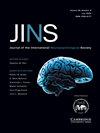Using augmented reality to assess spatial neglect: The Free Exploration Test (FET)
IF 2.6
4区 心理学
Q2 CLINICAL NEUROLOGY
Journal of the International Neuropsychological Society
Pub Date : 2024-09-18
DOI:10.1017/s1355617724000274
引用次数: 0
Abstract
Background: To capture the distortion of exploratory activity typical of patients with spatial neglect, traditional diagnostic methods and new virtual reality applications use confined workspaces that limit patients’ exploration behavior to a predefined area. Our aim was to overcome these limitations and enable the recording of patients’ biased activity in real, unconfined space. Methods: We developed the Free Exploration Test (FET) based on augmented reality technology. Using a live stream via the back camera on a tablet, patients search for a (non-existent) virtual target in their environment, while their exploration movements are recorded for 30 s. We tested 20 neglect patients and 20 healthy participants and compared the performance of the FET with traditional neglect tests. Results: In contrast to controls, neglect patients exhibited a significant rightward bias in exploratory movements. The FET had a high discriminative power (area under the curve = 0.89) and correlated positively with traditional tests of spatial neglect (Letter Cancellation, Bells Test, Copying Task, Line Bisection). An optimal cut-off point of the averaged bias of exploratory activity was at 9.0° on the right; it distinguished neglect patients from controls with 85% sensitivity. Discussion: FET offers time-efficient (execution time: ∼3 min), easy-to-apply, and gamified assessment of free exploratory activity. It supplements traditional neglect tests, providing unrestricted recording of exploration in the real, unconfined space surrounding the patient.利用增强现实技术评估空间忽视:自由探索测试 (FET)
背景:为了捕捉空间忽略症患者典型的探索活动失真,传统诊断方法和新的虚拟现实应用都使用封闭的工作空间,将患者的探索行为限制在预先设定的区域内。我们的目标是克服这些限制,在真实、无限制的空间中记录患者的偏差活动。方法:我们开发了基于增强现实技术的自由探索测试(FET)。通过平板电脑上的后置摄像头进行实时流媒体传输,患者在他们所处的环境中寻找一个(不存在的)虚拟目标,同时他们的探索动作将被记录 30 秒。我们对 20 名忽视患者和 20 名健康参与者进行了测试,并将自由探索测试的表现与传统的忽视测试进行了比较。测试结果与对照组相比,忽视患者的探索动作明显偏右。FET具有很高的辨别力(曲线下面积=0.89),并与传统的空间忽略测试(字母取消、铃铛测试、复制任务、线段分割)呈正相关。探索活动平均偏差的最佳分界点是右侧 9.0°;它能以 85% 的灵敏度将忽视患者与对照组区分开来。讨论自由探索活动评估(FET)提供了省时(执行时间:∼3 分钟)、易于应用和游戏化的自由探索活动评估。它是对传统忽视测试的补充,可在患者周围真实、无限制的空间内不受限制地记录探索活动。
本文章由计算机程序翻译,如有差异,请以英文原文为准。
求助全文
约1分钟内获得全文
求助全文
来源期刊
CiteScore
5.40
自引率
3.80%
发文量
185
审稿时长
4-8 weeks
期刊介绍:
The Journal of the International Neuropsychological Society is the official journal of the International Neuropsychological Society, an organization of over 4,500 international members from a variety of disciplines. The Journal of the International Neuropsychological Society welcomes original, creative, high quality research papers covering all areas of neuropsychology. The focus of articles may be primarily experimental, applied, or clinical. Contributions will broadly reflect the interest of all areas of neuropsychology, including but not limited to: development of cognitive processes, brain-behavior relationships, adult and pediatric neuropsychology, neurobehavioral syndromes (such as aphasia or apraxia), and the interfaces of neuropsychology with related areas such as behavioral neurology, neuropsychiatry, genetics, and cognitive neuroscience. Papers that utilize behavioral, neuroimaging, and electrophysiological measures are appropriate.
To assure maximum flexibility and to promote diverse mechanisms of scholarly communication, the following formats are available in addition to a Regular Research Article: Brief Communication is a shorter research article; Rapid Communication is intended for "fast breaking" new work that does not yet justify a full length article and is placed on a fast review track; Case Report is a theoretically important and unique case study; Critical Review and Short Review are thoughtful considerations of topics of importance to neuropsychology and include meta-analyses; Dialogue provides a forum for publishing two distinct positions on controversial issues in a point-counterpoint format; Special Issue and Special Section consist of several articles linked thematically; Letter to the Editor responds to recent articles published in the Journal of the International Neuropsychological Society; and Book Review, which is considered but is no longer solicited.

 求助内容:
求助内容: 应助结果提醒方式:
应助结果提醒方式:


